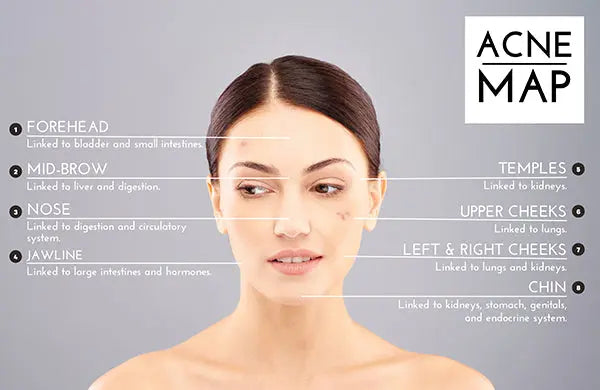
Acne on the face: what you did not know
Can acne be a symptom of something else?
Did you know that antibiotics to treat acne can cause a rebound effect on the skin and make acne more resistant? Or that some products for oily skin can make the problem worse? Read on and find out the whole truth about one of the most common conditions today.
Adult acne is becoming more and more common.
Although the hormones of puberty activate the production of the sebaceous glands, this does not mean that adults do not suffer from it. Adult acne or late acne is more common in women, although it also affects men. Currently, it is estimated that it affects 51% of women between 20 and 29 years old, 35% between 30 and 39 years old, 26% between 40 and 49 years old, and 15% of women over 50 years old.
- Among its leading causes are hormonal problems such as polycystic ovary syndrome, oral contraceptives, stress, and medications.
Hormonal birth control does not improve acne.
Contraceptives lower the levels of male hormones such as testosterone and androgens, which reduces sebum production and can decrease the appearance of acne. However, acne is a multifactorial condition, and oil production is not always the cause. Contraceptives do not cure acne but rather delay its appearance. The problem is that once its use is discontinued or the medication is changed, acne can manifest.
- This does not mean that if your doctor prescribed contraceptives for a hormonal problem or as a family planning method, you should stop them; you have to consider that they are not an acne treatment.
Oral antibiotics for acne can make it worse.
The goal of antibiotics or acne pills is to kill the pathogenic bacteria that cause acne. The problem often not mentioned is that they also eliminate beneficial bacteria for our body, causing an imbalance that weakens the immune system. Long-term antibiotics can cause a rebound effect, which specialists call "super-acne," a type of drug-resistant acne.
There are different types of acne, and some of them may require antibiotics for their treatment, such as severe acne, cystic acne, and nodular acne. However, today there are effective topical treatments that can improve bacterial acne without abusing medications.
We recommend using ingredients that attack acne bacteria, such as hydroxydecenoic acid, decane diol, terpinene-4-ol, benzoyl peroxide, and azelaic acid. To keep the bacterial flora in balance, opt for niacinamide, sebacic acid, and biotech glycoproteins like MRJP1.
Having acne is not a sign of poor hygiene.
Despite popular beliefs, acne is not strictly caused by dirty skin. It is proven that washing our face too often alters the acid mantle of the skin and the balance of the skin flora, making us more susceptible to acne bacteria. This occurs because when we wash our face excessively, we remove both harmful bacteria and the beneficial bacteria that our skin needs. It is advisable to wash our face twice a day: in the morning and at night.
If you have acne, avoid bar soaps and fragrances or alcohol cleaners. Opt for cleansing ingredients that gently remove excess sebum and dirt. Some examples are aloe vera, activated charcoal, lauryl sarcosinate, and coco amido betaine.
On the other hand, excessive friction can cause micro-injuries and inflame the skin. Avoid at all costs physical exfoliants with granules, facial brushes, makeup remover wipes, peel-off masks, blackhead suckers, and any product that can scratch your skin.
The best acne treatment is one that doesn't dry out your skin.
Products for oily or acneic skin often contain drying alcohols and other ingredients that destroy the natural oil in the skin, leaving it unprotected and prone to infection. In addition, this causes our face to produce more sebum as a defense mechanism.
If you have acne, avoid products that contain drying ingredients like tonics, purifying masks, and home remedies. Instead, look for products that contain multiple components for a comprehensive solution to the problem, as the vast majority are only effective for certain types of acne. Here are some recommendations to treat mild and moderate acne:
- Salicylic acid: Reduces swelling and redness of the skin, unclogs and improves the appearance of pores, allows blackheads to dry. Exfoliates and removes dead cells.
- Niacinamide: Calms skin redness, regulates oil production. Decreases the pigmentation of acne spots.
- Hydroxydecenoic acid (HDA): An ingredient that regulates oil production and prevents acne bacteria from increasing on the skin.
- Biotechnological Glycoprotein: Regenerates the skin and balances the bacterial flora. Helps the healing of acne lesions.
- Decanediol: Decreases the proliferation of bacteria that cause acne.
- Sebacic acid: It retains moisture and creates a protective layer that regulates fat production.
- Terpinen-4-ol: It is the most active ingredient in tea tree oil. It contains anti-inflammatory and antimicrobial properties, making it ideal for bacterial acne.
- If you have severe acne symptoms, such as nodules, cysts, or atrophic scars, you should see a dermatologist and, most importantly, do not self-medicate.
Acne does not heal over time.
- Although acne is associated with a hormonal activity that occurs in adolescence, it does not mean that once this stage of life is passed, it will disappear on its own. Acne is a disease that does not go away forever but can be controlled. It can reappear throughout our lives, and to avoid it, it is necessary to give it the appropriate treatment. Once the symptoms have been attacked, it is recommended to provide it with maintenance.
- In addition, acne can leave lesions in post-inflammatory spots, atrophic and hypertrophic scars. We recommend ingredients such as vitamin C, niacinamide, alpha arbutin, and phenyl resorcinol to reduce them.
Acne is not exclusive to the face.
Acne lesions appear mainly on our face, but they can also occur in the neck, back, arms, chest, and buttocks. This is due to the stimulation of the sebaceous glands, sweat, bacteria, and genetics.
Now you know some of the central myths related to acne and oily skin, leave us in the comments what was the data that surprised you the most and if you know any other. We love reading your opinion!


